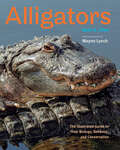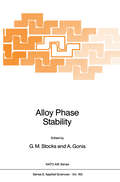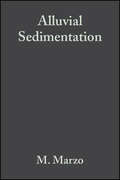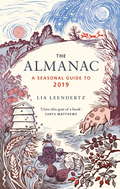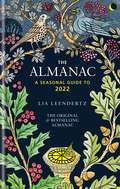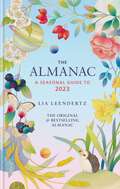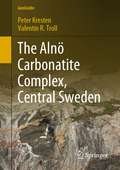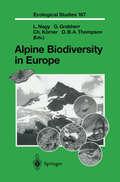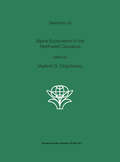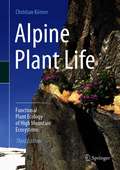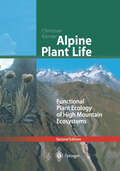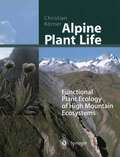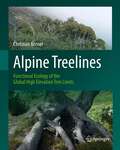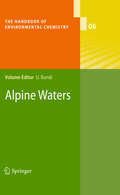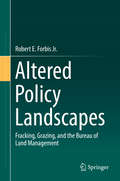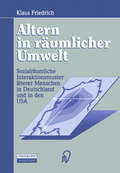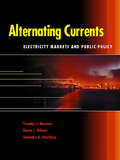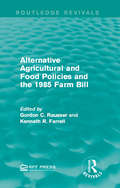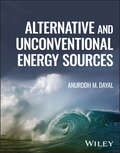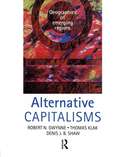- Table View
- List View
Alligators: The Illustrated Guide to Their Biology, Behavior, and Conservation
by Kent A. VlietFew scenes put the senses on edge more than a submerged alligator, only eyes and snout showing, when peering across a southern lake on a misty morning. An iconic American predator, these reptiles grow to thirteen feet or more and can live as long as humans. Alligators are complex creatures, capable of terrific attacks and yet tending to their young in the same gentle way a mother duck looks after her brood. Once extremely numerous, alligators came close to extinction in the twentieth century, but thanks to conservation efforts have since made a comeback, reclaiming their rightful place as the monarchs of the southern wetlands.In this fascinating account, richly illustrated with more than 150 photographs from award-winning wildlife photographer Wayne Lynch, expert zoologist Kent A. Vliet introduces readers to the biology, ecology, and natural history of the American alligator. Sharing nuanced depictions of their hidden lives that will forever change the way you think of these giant reptiles, the book• combines captivating storytelling with the most current scientific facts• chronicles the life cycle of the alligator• explains why the alligator's precise anatomy and physiology make it so successful• covers a wide range of topics, from courtship and reproduction to communication, basking, nest-building, and hunting• reveals the alligator's sophisticated social life in detail• evaluates the alligator's environmental role as a keystone species• examines the complicated relationship between alligators and people
Alloy Phase Stability (NATO Science Series E: #163)
by G. M. Stocks A. GonisOne of the ultimate goals of materials research is to develop a fun damental and predictive understanding of the physical and metallurgical properties of metals and alloys. Such an understanding can then be used in the design of materials having novel properties or combinations of proper ties designed to meet specific engineering applications. The development of new and useful alloy systems and the elucidation of their properties are the domain of metallurgy. Traditionally, the search for new alloy systems has been conducted largely on a trial and error basis, guided by the skill and intuition of the metallurgist, large volumes of experimental data, the principles of 19th century thermodynamics and ad hoc semi-phenomenological models. Recently, the situation has begun to change. For the first time, it is possible to understand the underlying mechanisms that control the formation of alloys and determine their properties. Today theory can begin to offer guidance in predicting the properties of alloys and in developing new alloy systems. Historically, attempts directed toward understanding phase stability and phase transitions have proceeded along distinct and seemingly diverse lines. Roughly, we can divide these approaches into the following broad categories. 1. Experimental determination of phase diagrams and related properties, 2. Thermodynamic/statistical mechanical approaches based on semi phenomenological models, and 3. Ab initio quantum mechanical methods. Metallurgists have traditionally concentrated their efforts in cate gories 1 and 2, while theoretical physicists have been preoccupied with 2 and 3.
Alluvial Sedimentation (International Association Of Sedimentologists Series #66)
by M. Marzo C. PuigdefabregasMost of the thirty-four papers contained in this Special Publication arise from the Fourth International Conference on Fluvial Sedimentology held in Spain in 1989. Sections deal with various aspects of sediment transport and hydraulics in flume experiments and modern rivers, the analysis of alluvial facies, geomorphic and structural controls on alluvial sedimentation, alluvial stratigraphy and basin analysis, and finally the exploration and exploitation of ores. A professional reference to the most recent research in fluvial sedimentology. An international expert authorship.
The Almanac: A Seasonal Guide to 2019
by Lia LeendertzTHE ORIGINAL & BESTSELLING ALMANAC 'I love this gem of a book' - Cerys Matthews 'This book is your bible' - The Independent '...it already feels like an annual necessity' - India Knight 'Joyous' - Allan Jenkins 'Updated for 2019 with more lovely ideas to celebrate the seasons' - Gardens Illustrated'A charming book. This is a real gem of a gift' - Sunday Express, S Magazine. A perfect toolkit connecting with the world around us and the year ahead as it unfolds - all in a compact and pocket size that just begs you to pick it up and browse - Reckless Gardener or Its range of information and depth of understanding of our seasons is priceless - Reckless GardenerThe Almanac: A Seasonal Guide to 2019 reinvents the tradition of the rural almanac for a new audience. It gives you the tools and inspiration you need to celebrate, mark and appreciate each month of the year in your own particular way. Divided into the 12 months, a set of tables each month gives it the feel and weight of a traditional almanac, providing practical information that gives access to the outdoors and the seasons, perfect for expeditions, meteor-spotting nights and beach holidays. There are also features on each month's unique nature, such as the meteor shower of the month, beehive behaviour, folklore and stories, seasonal recipes and charts tracking moon phases and tides. Why not try identifying trees by their bare buds in January; Enjoy Buttermilk scones with orangle blossom & honey butter in June; Discover the Chinese New Year story of 'The great race' in February.You will find yourself referring to the almanac all year long, revisiting it again and again, and looking forward to the next edition as the year draws to a close.Praise for The Almanac: A Seasonal Guide to 2018:'The perfect companion to the seasons' - India Knight'A richly layered book of events, celebrations and everyday information that together create a beautiful, fascinating resource . . . In the single month I've had my hands on it, the book has quietly "worked".' - Telegraph'Beautifully written, this pocket-sized guide is a labour of love and will remind you to appreciate little moments throughout the year.' - Gardens Illustrated'Elegant . . . an ideal stocking filler.' - The English Garden
The Almanac: A seasonal guide to 2022
by Lia Leendertz*THE ORIGINAL & BESTSELLING ALMANAC*A perfect toolkit for connecting with the world around us and the year ahead as it unfolds - all in a compact and pocket size guide that just begs you to pick it up and browse.The Almanac: A seasonal guide to 2022 reinvents the tradition of the rural almanac for a new audience. It gives you the tools and inspiration you need to celebrate, mark and appreciate each month of the year in your own particular way. Divided into the 12 months, a set of tables each month gives it the feel and weight of a traditional almanac, providing practical information that gives access to the outdoors and the seasons, perfect for expeditions, meteor-spotting nights and beach holidays. There are also features on each month's unique nature, such as the meteor shower of the month, beehive behaviour, folklore, seasonal recipes and charts tracking moon phases and tides.You will find yourself referring to The Almanac all year long, revisiting it again and again, and looking forward to the next edition as the year draws to a close.PRAISE FOR THE ALMANAC:'The perfect companion to the seasons' - India Knight'Indispensable' - Sir Bob Geldof'This book is your bible' - The Independent'An ideal stocking filler' - The English Garden'I love this gem of a book' - Cerys Matthews
The Almanac: THE SUNDAY TIMES BESTSELLER (Almanac)
by Lia LeendertzTHE ORIGINAL & SUNDAY TIMES BESTSELLING ALMANAC Reconnect with the seasons in Britain and Ireland with this month-by-month guide to the world around us - including key dates, tide tables and garden tasks; constellations and moon phases; sunrises, folk songs, seasonal recipes plus a 'bun of the month'; and - because 2023 will be a good year for planet spotting - the solar system and the zodiac.The Almanac: A Seasonal Guide to 2023 gives you the tools and inspiration you need to celebrate, mark and appreciate each month of the year in your own particular way. Divided into the 12 months, a set of tables each month gives it the feel and weight of a traditional almanac, providing practical information that gives access to the outdoors and the seasons, perfect for expeditions, meteor-spotting nights and beach holidays. There are also features on each month's unique nature, with this instalment following the swirling micro world of the garden pond through the year.You will find yourself referring to The Almanac all year long, revisiting it again and again, and looking forward to the next edition as the year draws to a close.This year's edition is illustrated by artist Whooli Chen.The geographical scope of The Almanac is Britain and IrelandPRAISE FOR THE ALMANAC:'Lia Leendertz's classic almanac never fails to delight' - The Herald'It's a perfect Christmas present' - Allan Jenkins, The Observer'The perfect companion to the seasons' - India Knight'Indispensable' - Sir Bob Geldof'This book is your bible' - The Independent'I love this gem of a book' - Cerys Matthews
The Alnö Carbonatite Complex, Central Sweden (GeoGuide)
by Valentin R. Troll Peter KrestenThis GeoGuide provides an overview of the geology of Alnö, combined with an up-to-date field itinerary. Covering all major geological aspects, it offers an essential summary of Alnö and its intriguing magmatic rocks in a compact form suitable for field excursions and home study alike. As one of the type localities for carbonatite, the late Proterozoic Alnö ring complex has been a crucial site for carbonatite-related research (next to the Fen complex in Norway), and provided one of the earliest test beds for this unique group of igneous rocks. Five geological excursions introduce the visitor to the most rewarding outcrops, including detailed descriptions and a wealth of high-quality colour photographs. The excursions are complemented by a detailed review of the history of scientific investigation on Alnö and, in particular, a catalogue of exotic and common minerals associated with the complex’s carbonatitic and alkaline silicate rocks. Finally, a summary of its trace element and isotope geochemistry as well as a brief outlook on Alnö’s potential as a future source of Rare Earth Elements (REEs) completes the book.
Alpine Biodiversity in Europe (Ecological Studies #167)
by Laszlo Nagy Georg Grabherr Christian Körner Desmond B. A. ThompsonThe United Nations Conference on the Environment and Development (UNCED), held in Rio de Janeiro in 1992, spawned a multitude of pro grammes aimed at assessing, managing and conserving the earth's biological diversity. One important issue addressed at the conference was the mountain environment. A specific feature of high mountains is the so-called alpine zone, i. e. the treeless regions at the uppermost reaches. Though covering only a very small proportion of the land surface, the alpine zone contains a rela tively large number of plants, animals, fungi and microbes which are specifi cally adapted to cold environments. This zone contributes fundamentally to the planet's biodiversity and provides many resources for mountain dwelling as well as lowland people. However, rapid and largely man-made changes are affecting mountain ecosystems, such as soil erosion, losses of habitat and genetic diversity, and climate change, all of which have to be addressed. As stated in the European Community Biodiversity Strategy, "the global scale of biodiversity reduction or losses and the interdependence of different species and ecosystems across national borders demands concerted international action". Managing biodiversity in a rational and sustainable way needs basic knowledge on its qualitative and quantitative aspects at local, regional and global scales. This is particularly true for mountains, which are distributed throughout the world and are indeed hot spots of biodiversity in absolute terms as well as relative to the surrounding lowlands.
Alpine Ecosystems in the Northwest Caucasus (Geobotany #29)
by Vladimir G. OnipchenkoPlant geographical description of the area, syntaxonomy, spatial patterns, floristic richness, structure of plant communities in relation to soil properties and herbivore influence were described for a mountain region that is difficult to access. Seasonal, inter-annual, and long-term dynamics of vegetation are discussed on the base of long-term observations as well as pollen and phytolith analyses. Population biology of alpine plants is studied by combination of field observations and mathematical modelling. Plant population strategies and soil seed banks are described for alpine plants from several communities. Results of long-term ecological experiments (plant reciprocal transplantations, dominant removals, light limitation) showed the significance of competition and facilitation for community organization. Structure of soil algal and fungal communities is represented as well as mycorrhiza of alpine plants. Main animal groups (wild) history and modern nature conservation problems are discussed.
Alpine Plant Life: Functional Plant Ecology of High Mountain Ecosystems
by Christian KörnerThis book is a completely revised, substantially extended treatment of the physical and biological factors that drive life in high mountains. The book covers the characteristics of alpine plant life, alpine climate and soils, life under snow, stress tolerance, treeline ecology, plant water, carbon, and nutrient relations, plant growth and productivity, developmental processes, and two largely novel chapters on alpine plant reproduction and global change biology. The book explains why the topography driven exposure of plants to dramatic micro-climatic gradients over very short distances causes alpine biodiversity to be particularly robust against climatic change. Geographically, this book draws on examples from all parts of the world, including the tropics. This book is complemented with novel evidence and insight that emerged over the last 17 years of alpine plant research. The number of figures – mostly in color – nearly doubled, with many photographs providing a vivid impression of alpine plant life worldwide.Christian Körner was born in 1949 in Austria, received his academic education at the University of Innsbruck, and was full professor of Botany at the University of Basel from 1989 to 2014. As emeritus Professor he is continuing alpine plant research in the Swiss Alps.
Alpine Plant Life: Functional Plant Ecology of High Mountain Ecosystems
by Christian KörnerGenerations of plant scientists have been fascinated by alpine plant life - with the exposure of organisms to dramatic climatic gradients over a very short distance. This comprehensive text treats a wide range of topics: alpine climate and soils, plant distribution and the treeline phenomenon, physiological ecology of water-, nutritional- and carbon relations of alpine plants, plant stress and plant development, biomass production, and aspects of human impacts on alpine vegetation. Geographically the book covers all parts of the world including the tropics.This second edition of Alpine Plant Life gives new references, new diagrams, and extensively revised chapters.
Alpine Plant Life: Functional Plant Ecology of High Mountain Ecosystems
by Christian KörnerGenerations of plant scientists have been fascinated by alpine plant lifean ecosystem that experiences dramatic climatic gradients over a very short distance. This comprehensive book examines a wide range of topics including alpine climate and soils, plant distribution and the treeline phenomenon, plant stress and development, global change at high elevation, and the human impact on alpine vegetation. Geographically, the book covers all parts of the world including the tropics.
Alpine Treelines: Functional Ecology of the Global High Elevation Tree Limits
by Christian KörnerAlpine treelines mark the low-temperature limit of tree growth and occur in mountains world-wide. Presenting a companion to his book Alpine Plant Life, Christian Körner provides a global synthesis of the treeline phenomenon from sub-arctic to equatorial latitudes and a functional explanation based on the biology of trees. The comprehensive text approaches the subject in a multi-disciplinary way by exploring forest patterns at the edge of tree life, tree morphology, anatomy, climatology and, based on this, modelling treeline position, describing reproduction and population processes, development, phenology, evolutionary aspects, as well as summarizing evidence on the physiology of carbon, water and nutrient relations, and stress physiology. It closes with an account on treelines in the past (palaeo-ecology) and a section on global change effects on treelines, now and in the future. With more than 100 illustrations, many of them in colour, the book shows alpine treelines from around the globe and offers a wealth of scientific information in the form of diagrams and tables.
Alpine Waters (The Handbook of Environmental Chemistry #6)
by Armin Peter Christopher T. Robinson Bruno Schädler Bernhard Truffer Stefan Vollenweider Bernhard Wehrli Rolf WeingartnerMost of the world’s mountains are rich in water and, as such, play a pivotal role in the global water cycle. They provide water for diverse human uses and ecosystems. Growing water demands as well as climate change will lead to ever-increasing pressure on mountain waters. Overcoming water-use conflicts and maintaining the ecological functioning of mountain waters presents a highly challenging task and is indispensable for sustainable development.This book extensively portrays the highly diverse attributes of mountain waters and demonstrates their paramount importance for ecological and societal development. The extensive summaries on the scientific basics of mountain waters are supplemented with considerations on the diverse water uses, needs for management actions, and challenges regarding sustainable water management. This overview concerns not only the mountain areas themselves but also downriver reaches and their surrounding lowlands, and, therefore, the relationship between mountain and lowland water issues.
Altered Policy Landscapes: Fracking, Grazing, and the Bureau of Land Management
by Robert E. Forbis Jr.This book documents the United States Bureau of Land Management's (BLM) shift from a rancher-dominated agency to an energy-dominated agency. This shift is analyzed by identifying the conditions under which the expansion of hydraulic fracturing (fracking) in the Rocky Mountain West triggered a political conflict between ranching and energy stakeholder groups. Through scrutiny of federal actions and policies implemented by the Executive Branch between 2004 and 2010, the book sheds light on the emphasis of domestic energy production during this time period, and how the traditional ranching and energy alliance was split by shifting policy interests. The book is meant for policy makers, natural resource agencies, and students and researchers engaged in political science, public administration, and natural resource management. Chapter 1 introduces readers to the case study at hand, and reviews literature on public land agencies and policies. Chapter 2 summarizes the legal history of public land management by the federal government, and the conditions that caused the BLM to favor energy development over ranching in the mid-2000's. Chapter 3 details the role of the Executive Branch (Bush-Cheney administration) in affecting the BLM's domestic energy policies and resource allocation, and chapter 4 analyzes the role of subgovernments in affecting the BLM's motivations too. Chapters 5, 6 and 7 contain first-hand accounts from government officials, state petroleum associations, and ranching supported interest groups to explore the concept of subgovernment stakeholder domination in policymaking, and analyze the similarities and differences between different policy-making elites. Chapter 8 concludes the text by summarizing subgovernment theory, mapping the behaviors of subgovernment actors, and discussing the implications for future political appointees in the direction of land-management agencies like the BLM.
Altern in räumlicher Umwelt: Sozialräumliche Interaktionsmuster älterer Menschen in Deutschland und in den USA
by Klaus FriedrichAlternating Currents: Electricity Markets and Public Policy
by Timothy J. Brennan Karen L. Palmer Salvador A. MartinezMany states within the U.S., and many countries across the world, are opening their electicity markets to competition. Many others are uncertain about their plans. These differences emphasize the complexities involved in the technology and regulatory structure of the electricity industry--an industry for which the introduction of market competition has been notoriously difficult. In response to these challenges, Alternating Currents provides a timely overview and analysis of the concerns facing industry regulators, legislators, and others as they consider whether, when, and how to open electricity markets. Authors Brennan, Palmer, and Martinez offer background on the history of regulatory policy and the technology for producing and delivering electric power. They then provide insights into the policy debates and economic issues involved in eleven important topics, including industry structure, system integrity and reliability, the mitigation of market power, and environmental protection. Alternating Currents describes the recent events leading to the demise of retail competition in California with the intent on drawing lessons for the future. In the end, the authors offer their perspective about what makes electricity a unique resource and how those factors make the potential conflict between competition and reliability the most pressing of the long-term concerns about the transformation of the electric power industry.
Alternating Currents: Electricity Markets and Public Policy
by Timothy J. Brennan Karen L. Palmer Salvador A. MartinezMany states within the U.S., and many countries across the world, are opening their electicity markets to competition. Many others are uncertain about their plans. These differences emphasize the complexities involved in the technology and regulatory structure of the electricity industry--an industry for which the introduction of market competition has been notoriously difficult. In response to these challenges, Alternating Currents provides a timely overview and analysis of the concerns facing industry regulators, legislators, and others as they consider whether, when, and how to open electricity markets. Authors Brennan, Palmer, and Martinez offer background on the history of regulatory policy and the technology for producing and delivering electric power. They then provide insights into the policy debates and economic issues involved in eleven important topics, including industry structure, system integrity and reliability, the mitigation of market power, and environmental protection. Alternating Currents describes the recent events leading to the demise of retail competition in California with the intent on drawing lessons for the future. In the end, the authors offer their perspective about what makes electricity a unique resource and how those factors make the potential conflict between competition and reliability the most pressing of the long-term concerns about the transformation of the electric power industry.
Alternative Agricultural and Food Policies and the 1985 Farm Bill (Routledge Revivals)
by Gordon C. Rausser Kenneth R. FarrellIn 1985, the U.S. Congress confronted the difficult and complex task of developing a 5-year omnibus legislation allowing for lower commodity prices. But, policies predicated on the concept of agriculture as a unique sector of the economy became less and less appropriate to the highly interdependent, open agricultural economy throughout the 1980s. First published in 1985, this collection of 16 papers and related discussions contained in these proceedings is an important contribution toward understanding the issues, options, and dilemmas in U.S. agricultural policy. This is an ideal title for students interested in environmental studies, agriculture, and national policy.
Alternative Agricultural and Food Policies and the 1985 Farm Bill (Routledge Revivals)
by Gordon C. Rausser Kenneth R. FarrellIn 1985, the U.S. Congress confronted the difficult and complex task of developing a 5-year omnibus legislation allowing for lower commodity prices. But, policies predicated on the concept of agriculture as a unique sector of the economy became less and less appropriate to the highly interdependent, open agricultural economy throughout the 1980s. First published in 1985, this collection of 16 papers and related discussions contained in these proceedings is an important contribution toward understanding the issues, options, and dilemmas in U.S. agricultural policy. This is an ideal title for students interested in environmental studies, agriculture, and national policy.
Alternative and Unconventional Energy Sources
by Anurodh M. DayalA timely volume for understanding our future energy landscape and for creating a bridge towards a decarbonized energy system Alternative and Unconventional Energy Sources discusses various alternative energy sources and their present usage, including wind, solar, ocean, and geothermal energy, along with unconventional fossil energy sources, such as shale gas. The text covers the development and global adoption of each energy source, along with their environmental and economic impacts, resulting in a comprehensive and in-depth treatment of the subject. This approach provides the reader with a one-stop reference for each particular energy source, making the information accessible to all, regardless of discipline or current level of experience with each energy source. Specific topics covered in Alternative and Unconventional Energy Sources include: The controversial perception of shale gas and its future potential as an energy source Technologies to reduce harmful emissions of CO2 and other waste gases and their potential to cause less global warming Downsides of commonly accepted alternative energy sources, such as the disposal of nuclear waste and land requirements for solar panels How undeveloped countries can make use of local energy sources to become more efficient and competitiveAlternative and Unconventional Energy Sources is a highly accessible and useful resource for geographers, geologists, petroleum engineers, renewable energy specialists, and policy makers who wish to understand the current state of global energy production and where the industry may turn in the coming years.
Alternative and Unconventional Energy Sources
by Anurodh M. DayalA timely volume for understanding our future energy landscape and for creating a bridge towards a decarbonized energy system Alternative and Unconventional Energy Sources discusses various alternative energy sources and their present usage, including wind, solar, ocean, and geothermal energy, along with unconventional fossil energy sources, such as shale gas. The text covers the development and global adoption of each energy source, along with their environmental and economic impacts, resulting in a comprehensive and in-depth treatment of the subject. This approach provides the reader with a one-stop reference for each particular energy source, making the information accessible to all, regardless of discipline or current level of experience with each energy source. Specific topics covered in Alternative and Unconventional Energy Sources include: The controversial perception of shale gas and its future potential as an energy source Technologies to reduce harmful emissions of CO2 and other waste gases and their potential to cause less global warming Downsides of commonly accepted alternative energy sources, such as the disposal of nuclear waste and land requirements for solar panels How undeveloped countries can make use of local energy sources to become more efficient and competitiveAlternative and Unconventional Energy Sources is a highly accessible and useful resource for geographers, geologists, petroleum engineers, renewable energy specialists, and policy makers who wish to understand the current state of global energy production and where the industry may turn in the coming years.
Alternative Arrangements for Marine Fisheries: An Overview (Routledge Revivals)
by Francis T. Christy, Jr.The maintenance of the freedom of fishing in the face of the changing circumstances that were occurring at the time of this title’s original publication in 1973 had produced several damaging consequences. It had led to considerable waste, in both biological and economic terms, and had been the source of increasing conflict. This waste can only be prevented by the adoption of management measures and by the removal of the condition of free and open access. This book explores various techniques for this, and will be of interest to students of environmental management.
Alternative Arrangements for Marine Fisheries: An Overview (Routledge Revivals)
by Francis T. Christy, Jr.The maintenance of the freedom of fishing in the face of the changing circumstances that were occurring at the time of this title’s original publication in 1973 had produced several damaging consequences. It had led to considerable waste, in both biological and economic terms, and had been the source of increasing conflict. This waste can only be prevented by the adoption of management measures and by the removal of the condition of free and open access. This book explores various techniques for this, and will be of interest to students of environmental management.
Alternative Capitalisms: Geographies of emerging regions
by Robert Gwynne Denis Shaw Thomas KlakThis book aims to examine the effects of globalization and economic and political transformations in those parts of the world which are now regularly referred to as 'emerging regions'. These are Latin America and the Caribbean, East Central Europe and the former Soviet Union and East Asia. This book breaks new ground in three areas. First of all it develops a critique of the use of the term "emerging regions" for geographers and social scientists and relates this to world-systems theory. Secondly, it explores the development trajectories and challenges of countries in this so-called emerging world, countries that will be crucial to the evolution of the world economy in the twenty-first century. Thirdly, it compares and contrasts the pathways of both economic and political change in the three world regions under focus. This is a unique approach in terms of books published in both geography and the social sciences.Within the context of the three world regions, the book combines historical and contemporary analysis of the evolving world-system. In these regions we are concerned to understand the historical expansion and extension of capitalism and how its contemporary forms of production, exchange and regulation are evolving. The authors believe that at the present time these processes have produced 'alternative capitalisms' - economic and associated developments which, while assuredly capitalist, differ in various ways from those typical of the capitalist West or 'core economies' of North America and Western Europe.
